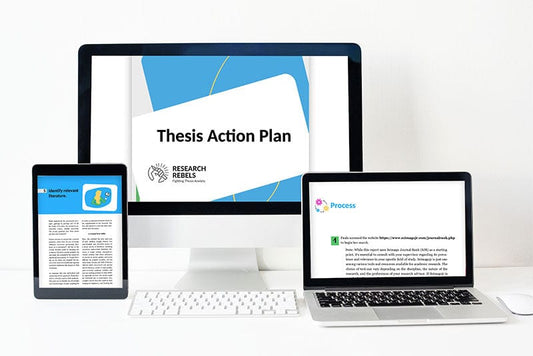How to Write Your Thesis in 10 Days: Your Countdown to Completion

Writing a thesis in just ten days might sound impossible, but with the right plan, it's totally doable. This guide is here to help you break it down into manageable steps, so you can stay on track and finish strong. Whether you're stuck on where to start or struggling with time management, we've got you covered. Let’s make those ten days count!
Key Takeaways
- Break your thesis into smaller, actionable tasks to make progress every day.
- Start with the sections you're most comfortable writing to build momentum.
- Stick to a realistic daily schedule; short, focused writing sessions are key.
- Use available resources like online guides and academic support groups.
- Celebrate small wins to stay motivated and manage stress effectively.
Crafting a Clear Research Question
Defining Your Hypothesis
The first step to writing a strong thesis is knowing what you're trying to prove or answer. This means defining your hypothesis in a way that's both specific and achievable. Think of it like this: your hypothesis is the anchor that holds your entire research together. Without it, you're just floating around aimlessly. A clear hypothesis gives your thesis direction and purpose. For example, instead of asking, "How does social media affect people?" you could narrow it down to "How does WhatsApp usage influence communication among college students?" See the difference? Specificity is key.
Aligning Your Question with Objectives
Once you've got your hypothesis, make sure it lines up with your research objectives. Ask yourself: What am I really trying to achieve with this study? Your objectives should act like a checklist for your research. If your question is about WhatsApp, your objectives might include understanding its role in daily communication, its impact on relationships, and maybe even how it compares to other platforms. Keeping everything aligned helps you stay focused and avoid veering off track.
Avoiding Common Pitfalls in Research Questions
Here’s where many students trip up. First, don't make your question too broad—it’s tempting, but it’ll make your research unmanageable. Second, avoid questions that are too vague. "Is WhatsApp good?" doesn’t really say much, does it? Instead, aim for something measurable and clear. Lastly, don’t overcomplicate it. A good research question is like a good tweet: clear, concise, and to the point.
Structuring Your Thesis for Maximum Impact
Organizing Chapters Effectively
Before diving into the writing, take a moment to outline your chapters. Think of your thesis as a story—it needs a clear beginning, middle, and end. Start with your introduction, where you’ll lay out the research question, objectives, and a brief overview of your methodology. Follow this with the literature review, methodology, results, discussion, and finally, the conclusion. Each chapter should serve a specific purpose and flow logically into the next. Keep your reader in mind—make it easy for them to follow your argument without getting lost.
Balancing Depth and Brevity
It’s tempting to include every detail of your research, but resist the urge. Focus on what’s essential to your argument. For example, when discussing your methodology, include enough detail for replication but avoid unnecessary technical jargon. Similarly, in your discussion, highlight the most significant findings and connect them to your research question. Brevity doesn’t mean skipping important points—it means presenting them as clearly and efficiently as possible.
Ensuring Logical Flow Between Sections
Transitions matter. A lot. If your reader has to pause to figure out how one section connects to the next, you’ve lost them. Use signposting to guide them, like starting a section with a sentence that links back to the previous one. For example, after presenting your results, you might begin your discussion with, “These findings suggest that...” to signal the shift from data to interpretation. Think of your thesis as a bridge—every section should support the next, creating a seamless path from start to finish.
Mastering Time Management During Thesis Writing
Creating a Realistic Daily Schedule
When you're writing a thesis, time can feel like your worst enemy. But it doesn’t have to be. A well-structured daily schedule can completely change the game. Start by identifying your most productive hours—are you an early bird or a night owl? Then, set aside those golden hours for your most challenging tasks, like drafting a tricky section or analyzing data. Avoid vague goals like “work on thesis.” Instead, go specific: “Write 500 words for Chapter 3” or “Revise the introduction.” This way, you know exactly what success looks like for the day.
Here’s a simple table to help you structure your day:
| Time Slot | Task |
|---|---|
| 8:00 AM - 9:30 AM | Write 500 words for Chapter 3 |
| 10:00 AM - 11:00 AM | Review feedback on Chapter 2 |
| 11:30 AM - 12:00 PM | Break and light reading |
| 1:00 PM - 2:00 PM | Analyze data for results |
| 2:30 PM - 3:00 PM | LinkedIn networking for post-thesis job search |
By sticking to a structured routine, you’ll not only make steady progress but also feel less overwhelmed.
Breaking Tasks into Manageable Steps
Big projects can feel paralyzing, and a thesis is no exception. The trick? Break it down. Think of your thesis as a series of small, manageable tasks rather than one giant monster. Instead of saying, "I need to write Chapter 2," break it into chunks: research, outline, draft, and revise. Each step is an accomplishment in itself, and ticking off these smaller tasks keeps you motivated.
Here’s a quick example of how you might break down a single chapter:
- Research relevant studies and take notes (Day 1-2).
- Draft an outline with key points (Day 3).
- Write the first draft of Section 1 (Day 4).
- Revise Section 1 and move to Section 2 (Day 5).
By focusing on one bite-sized piece at a time, you’ll find the process much less daunting.
Overcoming Procrastination with Proven Techniques
Procrastination is the silent killer of thesis progress. But you can fight back. One method is the Pomodoro Technique: work for 25 minutes, then take a 5-minute break. After four cycles, take a longer 15-30 minute break. It’s simple but effective, especially for tasks that feel endless. Another trick is to start with the easiest task on your list. Momentum is powerful—once you start, it’s easier to keep going.
Don’t forget to reward yourself. Finished a tough section? Treat yourself to something small, like your favorite snack or a quick scroll through LinkedIn to remind yourself why this thesis matters for your future. Rewards keep you motivated and make the process a little less grueling.
In short, managing your time well isn’t just about working harder—it’s about working smarter. With a clear plan, manageable steps, and a few tricks to beat procrastination, you’ll be crossing that finish line before you know it.
Enhancing Writing Efficiency and Quality
Starting with the Easiest Sections
When you sit down to write, begin with the sections that feel less intimidating. Tackling easier parts first—like the methodology or background—helps you build momentum. Starting small can make the larger tasks feel less overwhelming. Once you gain confidence, you can move on to more challenging sections, like the analysis or discussion.
Using Short Writing Bursts
Writing in short, focused sessions can work wonders. Aim for 45 minutes of concentrated effort followed by a 15-minute break. These breaks are not just about resting—they often spark fresh ideas when you step away from your desk. Make sure to turn off all distractions, like email and phone notifications, during these bursts to stay on track.
Incorporating Feedback Strategically
Feedback is essential, but it can also be overwhelming if not managed well. Focus on one section at a time when addressing comments from advisors or peers. This approach keeps the process organized and stops you from feeling swamped. Remember, feedback is not criticism—it’s a tool to refine your work. After making changes, take a step back to ensure the revisions fit seamlessly into the overall thesis structure.
By combining these strategies, you can streamline your writing, maintain high quality, and stay motivated throughout the process. For more tips on improving your thesis, check out our effective strategies for managing the process within tight timelines.
Leveraging Resources and Support Systems
Utilizing Online Courses and Guides
When you're knee-deep in thesis writing, structured online courses can be a game-changer. These courses often break down the process into daily tasks, allowing you to tackle your work step by step. For instance, some platforms provide interactive courses with daily checklists, helping you stay on track without feeling overwhelmed. These guides are particularly useful for clarifying complex topics, like organizing your research or refining your methodology. Consistency is key, and structured resources ensure you’re progressing steadily.
Seeking Personalized Coaching
Sometimes, you need more than just a guide—you need someone who understands your specific challenges. This is where personalized coaching comes in. Academic coaches offer tailored advice, whether you’re stuck on your thesis structure or struggling with writer’s block. They can also help you manage stress, set realistic goals, and keep you accountable. Group coaching sessions are another option, where you can share insights and learn from peers. Sharing experiences in these settings often provides a fresh perspective and renewed motivation.
Building a Supportive Academic Network
Never underestimate the power of a good support system. Whether it’s connecting with fellow students on platforms like Instagram or joining academic forums, having a network can make the journey less isolating. Share your progress, ask for feedback, or simply vent about the challenges you’re facing. Many students find that informal collaborations—like swapping editing services or discussing ideas—can be incredibly helpful. Surrounding yourself with people who understand your struggles can keep you motivated and focused.
Maintaining Motivation and Mental Well-Being

Setting Achievable Milestones
Breaking your thesis journey into smaller, realistic goals can make the process feel less overwhelming. Start by identifying key milestones, such as completing a chapter draft or finalizing your bibliography. Celebrate each accomplishment, no matter how small—it’s a reminder that you’re making progress. Consider using a simple table to track milestones:
| Milestone | Target Date | Status |
|---|---|---|
| Chapter 1 Draft | March 5, 2025 | In Progress |
| Literature Review | March 12, 2025 | Not Started |
| Final Submission | April 1, 2025 | Pending |
This kind of visual tracker keeps you focused and motivated.
Managing Stress Effectively
Stress is inevitable, but how you handle it makes all the difference. Start your day by asking, “What’s one thing I can do today to move my thesis forward?” This keeps your focus on action rather than anxiety. Build rituals that help you relax, like journaling or taking short walks. If you feel stuck, remember that disengaging from one task to focus on another can significantly improve your well-being, as supported by insights from 2,559 Kindle readers.
Celebrating Small Wins Along the Way
Don’t wait for the final submission to reward yourself. Treat yourself when you meet small goals—maybe it’s enjoying your favorite coffee or spending an evening with friends. These moments of joy recharge your energy and keep you motivated. Remember, every step forward, no matter how minor, is a victory in itself.
Polishing and Finalizing Your Thesis
Editing for Clarity and Precision
Once you’ve completed your draft, it’s time to refine your writing. Go through each section and ask yourself, “Does this make sense to someone outside my field?” Clear and concise writing is key. Avoid unnecessary jargon and ensure your arguments are easy to follow. Pay attention to grammar, punctuation, and sentence structure. Tools like spell checkers can help, but don’t rely on them entirely. A good tip? Read your work out loud—it’s surprising how many awkward phrases you’ll catch that way.
Formatting According to Guidelines
Every university has its own rules for thesis formatting. Double-check the requirements for margins, font size, citation style, and even the order of sections. It’s tedious, yes, but ignoring these details can cost you. Make a checklist of formatting rules and tackle them one by one. If your university provides a thesis template, use it—it’ll save you hours of frustration.
Preparing for Submission and Defense
Before you submit, review your thesis as if you were on the committee. Are all your arguments supported by evidence? Do your conclusions tie back to your research question? Address any weak spots. Once you’re satisfied, print a hard copy (if required) and check for printing errors. For the defense, practice summarizing your thesis in under 5 minutes. Anticipate questions and prepare thoughtful answers. Remember, the defense is your chance to showcase your hard work, so approach it with confidence and preparation.
When you're wrapping up your thesis, it's important to make sure everything is just right. Take a moment to review your work carefully. Check for any mistakes and make sure your ideas are clear. If you need help, visit our website for tips and tools that can make this process easier. Don't let stress hold you back!
Conclusion
Writing a thesis in just 10 days may sound like a tall order, but with the right plan and mindset, it’s absolutely achievable. By breaking the process into manageable daily tasks, staying consistent, and focusing on one step at a time, you can make steady progress without feeling overwhelmed. Remember, the key is to stay organized, avoid perfectionism, and give yourself room to breathe. Whether it’s setting clear goals, taking short breaks, or seeking guidance when needed, every small action adds up. So, take a deep breath, trust the process, and start writing. You’ve got this!
Frequently Asked Questions
How can I write my thesis in just 10 days?
To write your thesis in 10 days, break it into smaller, daily tasks. Focus on one section at a time, starting with the easiest parts. Stick to a realistic schedule, take short breaks, and avoid distractions like social media.
What should I do if I don't know where to start?
Begin with the methods section, as it’s often the simplest to write. This helps you build momentum and gain confidence before tackling more complex sections like the introduction or discussion.
How do I avoid procrastination while writing my thesis?
Set clear, specific goals for each day, like writing two pages or completing one figure. Use short, focused writing sessions of 45 minutes with 15-minute breaks to stay productive.
What resources can help me during the thesis process?
Online courses, step-by-step guides, and personalized coaching are great resources. Additionally, connect with a supportive academic network to share ideas and get feedback.
How do I stay motivated when the process feels overwhelming?
Break your work into smaller milestones and celebrate each achievement, no matter how small. Remember why your thesis is important and keep your end goals in mind.
What are the most common mistakes to avoid when writing a thesis?
Avoid starting without a clear research question, skipping daily writing sessions, and over-editing early drafts. Focus on progress over perfection to keep moving forward.
How to Write Your Thesis in 10 Days: Your Countdown to Completion

Writing a thesis in just ten days might sound impossible, but with the right plan, it's totally doable. This guide is here to help you break it down into manageable steps, so you can stay on track and finish strong. Whether you're stuck on where to start or struggling with time management, we've got you covered. Let’s make those ten days count!
Key Takeaways
- Break your thesis into smaller, actionable tasks to make progress every day.
- Start with the sections you're most comfortable writing to build momentum.
- Stick to a realistic daily schedule; short, focused writing sessions are key.
- Use available resources like online guides and academic support groups.
- Celebrate small wins to stay motivated and manage stress effectively.
Crafting a Clear Research Question
Defining Your Hypothesis
The first step to writing a strong thesis is knowing what you're trying to prove or answer. This means defining your hypothesis in a way that's both specific and achievable. Think of it like this: your hypothesis is the anchor that holds your entire research together. Without it, you're just floating around aimlessly. A clear hypothesis gives your thesis direction and purpose. For example, instead of asking, "How does social media affect people?" you could narrow it down to "How does WhatsApp usage influence communication among college students?" See the difference? Specificity is key.
Aligning Your Question with Objectives
Once you've got your hypothesis, make sure it lines up with your research objectives. Ask yourself: What am I really trying to achieve with this study? Your objectives should act like a checklist for your research. If your question is about WhatsApp, your objectives might include understanding its role in daily communication, its impact on relationships, and maybe even how it compares to other platforms. Keeping everything aligned helps you stay focused and avoid veering off track.
Avoiding Common Pitfalls in Research Questions
Here’s where many students trip up. First, don't make your question too broad—it’s tempting, but it’ll make your research unmanageable. Second, avoid questions that are too vague. "Is WhatsApp good?" doesn’t really say much, does it? Instead, aim for something measurable and clear. Lastly, don’t overcomplicate it. A good research question is like a good tweet: clear, concise, and to the point.
Structuring Your Thesis for Maximum Impact
Organizing Chapters Effectively
Before diving into the writing, take a moment to outline your chapters. Think of your thesis as a story—it needs a clear beginning, middle, and end. Start with your introduction, where you’ll lay out the research question, objectives, and a brief overview of your methodology. Follow this with the literature review, methodology, results, discussion, and finally, the conclusion. Each chapter should serve a specific purpose and flow logically into the next. Keep your reader in mind—make it easy for them to follow your argument without getting lost.
Balancing Depth and Brevity
It’s tempting to include every detail of your research, but resist the urge. Focus on what’s essential to your argument. For example, when discussing your methodology, include enough detail for replication but avoid unnecessary technical jargon. Similarly, in your discussion, highlight the most significant findings and connect them to your research question. Brevity doesn’t mean skipping important points—it means presenting them as clearly and efficiently as possible.
Ensuring Logical Flow Between Sections
Transitions matter. A lot. If your reader has to pause to figure out how one section connects to the next, you’ve lost them. Use signposting to guide them, like starting a section with a sentence that links back to the previous one. For example, after presenting your results, you might begin your discussion with, “These findings suggest that...” to signal the shift from data to interpretation. Think of your thesis as a bridge—every section should support the next, creating a seamless path from start to finish.
Mastering Time Management During Thesis Writing
Creating a Realistic Daily Schedule
When you're writing a thesis, time can feel like your worst enemy. But it doesn’t have to be. A well-structured daily schedule can completely change the game. Start by identifying your most productive hours—are you an early bird or a night owl? Then, set aside those golden hours for your most challenging tasks, like drafting a tricky section or analyzing data. Avoid vague goals like “work on thesis.” Instead, go specific: “Write 500 words for Chapter 3” or “Revise the introduction.” This way, you know exactly what success looks like for the day.
Here’s a simple table to help you structure your day:
| Time Slot | Task |
|---|---|
| 8:00 AM - 9:30 AM | Write 500 words for Chapter 3 |
| 10:00 AM - 11:00 AM | Review feedback on Chapter 2 |
| 11:30 AM - 12:00 PM | Break and light reading |
| 1:00 PM - 2:00 PM | Analyze data for results |
| 2:30 PM - 3:00 PM | LinkedIn networking for post-thesis job search |
By sticking to a structured routine, you’ll not only make steady progress but also feel less overwhelmed.
Breaking Tasks into Manageable Steps
Big projects can feel paralyzing, and a thesis is no exception. The trick? Break it down. Think of your thesis as a series of small, manageable tasks rather than one giant monster. Instead of saying, "I need to write Chapter 2," break it into chunks: research, outline, draft, and revise. Each step is an accomplishment in itself, and ticking off these smaller tasks keeps you motivated.
Here’s a quick example of how you might break down a single chapter:
- Research relevant studies and take notes (Day 1-2).
- Draft an outline with key points (Day 3).
- Write the first draft of Section 1 (Day 4).
- Revise Section 1 and move to Section 2 (Day 5).
By focusing on one bite-sized piece at a time, you’ll find the process much less daunting.
Overcoming Procrastination with Proven Techniques
Procrastination is the silent killer of thesis progress. But you can fight back. One method is the Pomodoro Technique: work for 25 minutes, then take a 5-minute break. After four cycles, take a longer 15-30 minute break. It’s simple but effective, especially for tasks that feel endless. Another trick is to start with the easiest task on your list. Momentum is powerful—once you start, it’s easier to keep going.
Don’t forget to reward yourself. Finished a tough section? Treat yourself to something small, like your favorite snack or a quick scroll through LinkedIn to remind yourself why this thesis matters for your future. Rewards keep you motivated and make the process a little less grueling.
In short, managing your time well isn’t just about working harder—it’s about working smarter. With a clear plan, manageable steps, and a few tricks to beat procrastination, you’ll be crossing that finish line before you know it.
Enhancing Writing Efficiency and Quality
Starting with the Easiest Sections
When you sit down to write, begin with the sections that feel less intimidating. Tackling easier parts first—like the methodology or background—helps you build momentum. Starting small can make the larger tasks feel less overwhelming. Once you gain confidence, you can move on to more challenging sections, like the analysis or discussion.
Using Short Writing Bursts
Writing in short, focused sessions can work wonders. Aim for 45 minutes of concentrated effort followed by a 15-minute break. These breaks are not just about resting—they often spark fresh ideas when you step away from your desk. Make sure to turn off all distractions, like email and phone notifications, during these bursts to stay on track.
Incorporating Feedback Strategically
Feedback is essential, but it can also be overwhelming if not managed well. Focus on one section at a time when addressing comments from advisors or peers. This approach keeps the process organized and stops you from feeling swamped. Remember, feedback is not criticism—it’s a tool to refine your work. After making changes, take a step back to ensure the revisions fit seamlessly into the overall thesis structure.
By combining these strategies, you can streamline your writing, maintain high quality, and stay motivated throughout the process. For more tips on improving your thesis, check out our effective strategies for managing the process within tight timelines.
Leveraging Resources and Support Systems
Utilizing Online Courses and Guides
When you're knee-deep in thesis writing, structured online courses can be a game-changer. These courses often break down the process into daily tasks, allowing you to tackle your work step by step. For instance, some platforms provide interactive courses with daily checklists, helping you stay on track without feeling overwhelmed. These guides are particularly useful for clarifying complex topics, like organizing your research or refining your methodology. Consistency is key, and structured resources ensure you’re progressing steadily.
Seeking Personalized Coaching
Sometimes, you need more than just a guide—you need someone who understands your specific challenges. This is where personalized coaching comes in. Academic coaches offer tailored advice, whether you’re stuck on your thesis structure or struggling with writer’s block. They can also help you manage stress, set realistic goals, and keep you accountable. Group coaching sessions are another option, where you can share insights and learn from peers. Sharing experiences in these settings often provides a fresh perspective and renewed motivation.
Building a Supportive Academic Network
Never underestimate the power of a good support system. Whether it’s connecting with fellow students on platforms like Instagram or joining academic forums, having a network can make the journey less isolating. Share your progress, ask for feedback, or simply vent about the challenges you’re facing. Many students find that informal collaborations—like swapping editing services or discussing ideas—can be incredibly helpful. Surrounding yourself with people who understand your struggles can keep you motivated and focused.
Maintaining Motivation and Mental Well-Being

Setting Achievable Milestones
Breaking your thesis journey into smaller, realistic goals can make the process feel less overwhelming. Start by identifying key milestones, such as completing a chapter draft or finalizing your bibliography. Celebrate each accomplishment, no matter how small—it’s a reminder that you’re making progress. Consider using a simple table to track milestones:
| Milestone | Target Date | Status |
|---|---|---|
| Chapter 1 Draft | March 5, 2025 | In Progress |
| Literature Review | March 12, 2025 | Not Started |
| Final Submission | April 1, 2025 | Pending |
This kind of visual tracker keeps you focused and motivated.
Managing Stress Effectively
Stress is inevitable, but how you handle it makes all the difference. Start your day by asking, “What’s one thing I can do today to move my thesis forward?” This keeps your focus on action rather than anxiety. Build rituals that help you relax, like journaling or taking short walks. If you feel stuck, remember that disengaging from one task to focus on another can significantly improve your well-being, as supported by insights from 2,559 Kindle readers.
Celebrating Small Wins Along the Way
Don’t wait for the final submission to reward yourself. Treat yourself when you meet small goals—maybe it’s enjoying your favorite coffee or spending an evening with friends. These moments of joy recharge your energy and keep you motivated. Remember, every step forward, no matter how minor, is a victory in itself.
Polishing and Finalizing Your Thesis
Editing for Clarity and Precision
Once you’ve completed your draft, it’s time to refine your writing. Go through each section and ask yourself, “Does this make sense to someone outside my field?” Clear and concise writing is key. Avoid unnecessary jargon and ensure your arguments are easy to follow. Pay attention to grammar, punctuation, and sentence structure. Tools like spell checkers can help, but don’t rely on them entirely. A good tip? Read your work out loud—it’s surprising how many awkward phrases you’ll catch that way.
Formatting According to Guidelines
Every university has its own rules for thesis formatting. Double-check the requirements for margins, font size, citation style, and even the order of sections. It’s tedious, yes, but ignoring these details can cost you. Make a checklist of formatting rules and tackle them one by one. If your university provides a thesis template, use it—it’ll save you hours of frustration.
Preparing for Submission and Defense
Before you submit, review your thesis as if you were on the committee. Are all your arguments supported by evidence? Do your conclusions tie back to your research question? Address any weak spots. Once you’re satisfied, print a hard copy (if required) and check for printing errors. For the defense, practice summarizing your thesis in under 5 minutes. Anticipate questions and prepare thoughtful answers. Remember, the defense is your chance to showcase your hard work, so approach it with confidence and preparation.
When you're wrapping up your thesis, it's important to make sure everything is just right. Take a moment to review your work carefully. Check for any mistakes and make sure your ideas are clear. If you need help, visit our website for tips and tools that can make this process easier. Don't let stress hold you back!
Conclusion
Writing a thesis in just 10 days may sound like a tall order, but with the right plan and mindset, it’s absolutely achievable. By breaking the process into manageable daily tasks, staying consistent, and focusing on one step at a time, you can make steady progress without feeling overwhelmed. Remember, the key is to stay organized, avoid perfectionism, and give yourself room to breathe. Whether it’s setting clear goals, taking short breaks, or seeking guidance when needed, every small action adds up. So, take a deep breath, trust the process, and start writing. You’ve got this!
Frequently Asked Questions
How can I write my thesis in just 10 days?
To write your thesis in 10 days, break it into smaller, daily tasks. Focus on one section at a time, starting with the easiest parts. Stick to a realistic schedule, take short breaks, and avoid distractions like social media.
What should I do if I don't know where to start?
Begin with the methods section, as it’s often the simplest to write. This helps you build momentum and gain confidence before tackling more complex sections like the introduction or discussion.
How do I avoid procrastination while writing my thesis?
Set clear, specific goals for each day, like writing two pages or completing one figure. Use short, focused writing sessions of 45 minutes with 15-minute breaks to stay productive.
What resources can help me during the thesis process?
Online courses, step-by-step guides, and personalized coaching are great resources. Additionally, connect with a supportive academic network to share ideas and get feedback.
How do I stay motivated when the process feels overwhelming?
Break your work into smaller milestones and celebrate each achievement, no matter how small. Remember why your thesis is important and keep your end goals in mind.
What are the most common mistakes to avoid when writing a thesis?
Avoid starting without a clear research question, skipping daily writing sessions, and over-editing early drafts. Focus on progress over perfection to keep moving forward.
How to Write Your Thesis in 10 Days: Your Countdown to Completion

Writing a thesis in just ten days might sound impossible, but with the right plan, it's totally doable. This guide is here to help you break it down into manageable steps, so you can stay on track and finish strong. Whether you're stuck on where to start or struggling with time management, we've got you covered. Let’s make those ten days count!
Key Takeaways
- Break your thesis into smaller, actionable tasks to make progress every day.
- Start with the sections you're most comfortable writing to build momentum.
- Stick to a realistic daily schedule; short, focused writing sessions are key.
- Use available resources like online guides and academic support groups.
- Celebrate small wins to stay motivated and manage stress effectively.
Crafting a Clear Research Question
Defining Your Hypothesis
The first step to writing a strong thesis is knowing what you're trying to prove or answer. This means defining your hypothesis in a way that's both specific and achievable. Think of it like this: your hypothesis is the anchor that holds your entire research together. Without it, you're just floating around aimlessly. A clear hypothesis gives your thesis direction and purpose. For example, instead of asking, "How does social media affect people?" you could narrow it down to "How does WhatsApp usage influence communication among college students?" See the difference? Specificity is key.
Aligning Your Question with Objectives
Once you've got your hypothesis, make sure it lines up with your research objectives. Ask yourself: What am I really trying to achieve with this study? Your objectives should act like a checklist for your research. If your question is about WhatsApp, your objectives might include understanding its role in daily communication, its impact on relationships, and maybe even how it compares to other platforms. Keeping everything aligned helps you stay focused and avoid veering off track.
Avoiding Common Pitfalls in Research Questions
Here’s where many students trip up. First, don't make your question too broad—it’s tempting, but it’ll make your research unmanageable. Second, avoid questions that are too vague. "Is WhatsApp good?" doesn’t really say much, does it? Instead, aim for something measurable and clear. Lastly, don’t overcomplicate it. A good research question is like a good tweet: clear, concise, and to the point.
Structuring Your Thesis for Maximum Impact
Organizing Chapters Effectively
Before diving into the writing, take a moment to outline your chapters. Think of your thesis as a story—it needs a clear beginning, middle, and end. Start with your introduction, where you’ll lay out the research question, objectives, and a brief overview of your methodology. Follow this with the literature review, methodology, results, discussion, and finally, the conclusion. Each chapter should serve a specific purpose and flow logically into the next. Keep your reader in mind—make it easy for them to follow your argument without getting lost.
Balancing Depth and Brevity
It’s tempting to include every detail of your research, but resist the urge. Focus on what’s essential to your argument. For example, when discussing your methodology, include enough detail for replication but avoid unnecessary technical jargon. Similarly, in your discussion, highlight the most significant findings and connect them to your research question. Brevity doesn’t mean skipping important points—it means presenting them as clearly and efficiently as possible.
Ensuring Logical Flow Between Sections
Transitions matter. A lot. If your reader has to pause to figure out how one section connects to the next, you’ve lost them. Use signposting to guide them, like starting a section with a sentence that links back to the previous one. For example, after presenting your results, you might begin your discussion with, “These findings suggest that...” to signal the shift from data to interpretation. Think of your thesis as a bridge—every section should support the next, creating a seamless path from start to finish.
Mastering Time Management During Thesis Writing
Creating a Realistic Daily Schedule
When you're writing a thesis, time can feel like your worst enemy. But it doesn’t have to be. A well-structured daily schedule can completely change the game. Start by identifying your most productive hours—are you an early bird or a night owl? Then, set aside those golden hours for your most challenging tasks, like drafting a tricky section or analyzing data. Avoid vague goals like “work on thesis.” Instead, go specific: “Write 500 words for Chapter 3” or “Revise the introduction.” This way, you know exactly what success looks like for the day.
Here’s a simple table to help you structure your day:
| Time Slot | Task |
|---|---|
| 8:00 AM - 9:30 AM | Write 500 words for Chapter 3 |
| 10:00 AM - 11:00 AM | Review feedback on Chapter 2 |
| 11:30 AM - 12:00 PM | Break and light reading |
| 1:00 PM - 2:00 PM | Analyze data for results |
| 2:30 PM - 3:00 PM | LinkedIn networking for post-thesis job search |
By sticking to a structured routine, you’ll not only make steady progress but also feel less overwhelmed.
Breaking Tasks into Manageable Steps
Big projects can feel paralyzing, and a thesis is no exception. The trick? Break it down. Think of your thesis as a series of small, manageable tasks rather than one giant monster. Instead of saying, "I need to write Chapter 2," break it into chunks: research, outline, draft, and revise. Each step is an accomplishment in itself, and ticking off these smaller tasks keeps you motivated.
Here’s a quick example of how you might break down a single chapter:
- Research relevant studies and take notes (Day 1-2).
- Draft an outline with key points (Day 3).
- Write the first draft of Section 1 (Day 4).
- Revise Section 1 and move to Section 2 (Day 5).
By focusing on one bite-sized piece at a time, you’ll find the process much less daunting.
Overcoming Procrastination with Proven Techniques
Procrastination is the silent killer of thesis progress. But you can fight back. One method is the Pomodoro Technique: work for 25 minutes, then take a 5-minute break. After four cycles, take a longer 15-30 minute break. It’s simple but effective, especially for tasks that feel endless. Another trick is to start with the easiest task on your list. Momentum is powerful—once you start, it’s easier to keep going.
Don’t forget to reward yourself. Finished a tough section? Treat yourself to something small, like your favorite snack or a quick scroll through LinkedIn to remind yourself why this thesis matters for your future. Rewards keep you motivated and make the process a little less grueling.
In short, managing your time well isn’t just about working harder—it’s about working smarter. With a clear plan, manageable steps, and a few tricks to beat procrastination, you’ll be crossing that finish line before you know it.
Enhancing Writing Efficiency and Quality
Starting with the Easiest Sections
When you sit down to write, begin with the sections that feel less intimidating. Tackling easier parts first—like the methodology or background—helps you build momentum. Starting small can make the larger tasks feel less overwhelming. Once you gain confidence, you can move on to more challenging sections, like the analysis or discussion.
Using Short Writing Bursts
Writing in short, focused sessions can work wonders. Aim for 45 minutes of concentrated effort followed by a 15-minute break. These breaks are not just about resting—they often spark fresh ideas when you step away from your desk. Make sure to turn off all distractions, like email and phone notifications, during these bursts to stay on track.
Incorporating Feedback Strategically
Feedback is essential, but it can also be overwhelming if not managed well. Focus on one section at a time when addressing comments from advisors or peers. This approach keeps the process organized and stops you from feeling swamped. Remember, feedback is not criticism—it’s a tool to refine your work. After making changes, take a step back to ensure the revisions fit seamlessly into the overall thesis structure.
By combining these strategies, you can streamline your writing, maintain high quality, and stay motivated throughout the process. For more tips on improving your thesis, check out our effective strategies for managing the process within tight timelines.
Leveraging Resources and Support Systems
Utilizing Online Courses and Guides
When you're knee-deep in thesis writing, structured online courses can be a game-changer. These courses often break down the process into daily tasks, allowing you to tackle your work step by step. For instance, some platforms provide interactive courses with daily checklists, helping you stay on track without feeling overwhelmed. These guides are particularly useful for clarifying complex topics, like organizing your research or refining your methodology. Consistency is key, and structured resources ensure you’re progressing steadily.
Seeking Personalized Coaching
Sometimes, you need more than just a guide—you need someone who understands your specific challenges. This is where personalized coaching comes in. Academic coaches offer tailored advice, whether you’re stuck on your thesis structure or struggling with writer’s block. They can also help you manage stress, set realistic goals, and keep you accountable. Group coaching sessions are another option, where you can share insights and learn from peers. Sharing experiences in these settings often provides a fresh perspective and renewed motivation.
Building a Supportive Academic Network
Never underestimate the power of a good support system. Whether it’s connecting with fellow students on platforms like Instagram or joining academic forums, having a network can make the journey less isolating. Share your progress, ask for feedback, or simply vent about the challenges you’re facing. Many students find that informal collaborations—like swapping editing services or discussing ideas—can be incredibly helpful. Surrounding yourself with people who understand your struggles can keep you motivated and focused.
Maintaining Motivation and Mental Well-Being

Setting Achievable Milestones
Breaking your thesis journey into smaller, realistic goals can make the process feel less overwhelming. Start by identifying key milestones, such as completing a chapter draft or finalizing your bibliography. Celebrate each accomplishment, no matter how small—it’s a reminder that you’re making progress. Consider using a simple table to track milestones:
| Milestone | Target Date | Status |
|---|---|---|
| Chapter 1 Draft | March 5, 2025 | In Progress |
| Literature Review | March 12, 2025 | Not Started |
| Final Submission | April 1, 2025 | Pending |
This kind of visual tracker keeps you focused and motivated.
Managing Stress Effectively
Stress is inevitable, but how you handle it makes all the difference. Start your day by asking, “What’s one thing I can do today to move my thesis forward?” This keeps your focus on action rather than anxiety. Build rituals that help you relax, like journaling or taking short walks. If you feel stuck, remember that disengaging from one task to focus on another can significantly improve your well-being, as supported by insights from 2,559 Kindle readers.
Celebrating Small Wins Along the Way
Don’t wait for the final submission to reward yourself. Treat yourself when you meet small goals—maybe it’s enjoying your favorite coffee or spending an evening with friends. These moments of joy recharge your energy and keep you motivated. Remember, every step forward, no matter how minor, is a victory in itself.
Polishing and Finalizing Your Thesis
Editing for Clarity and Precision
Once you’ve completed your draft, it’s time to refine your writing. Go through each section and ask yourself, “Does this make sense to someone outside my field?” Clear and concise writing is key. Avoid unnecessary jargon and ensure your arguments are easy to follow. Pay attention to grammar, punctuation, and sentence structure. Tools like spell checkers can help, but don’t rely on them entirely. A good tip? Read your work out loud—it’s surprising how many awkward phrases you’ll catch that way.
Formatting According to Guidelines
Every university has its own rules for thesis formatting. Double-check the requirements for margins, font size, citation style, and even the order of sections. It’s tedious, yes, but ignoring these details can cost you. Make a checklist of formatting rules and tackle them one by one. If your university provides a thesis template, use it—it’ll save you hours of frustration.
Preparing for Submission and Defense
Before you submit, review your thesis as if you were on the committee. Are all your arguments supported by evidence? Do your conclusions tie back to your research question? Address any weak spots. Once you’re satisfied, print a hard copy (if required) and check for printing errors. For the defense, practice summarizing your thesis in under 5 minutes. Anticipate questions and prepare thoughtful answers. Remember, the defense is your chance to showcase your hard work, so approach it with confidence and preparation.
When you're wrapping up your thesis, it's important to make sure everything is just right. Take a moment to review your work carefully. Check for any mistakes and make sure your ideas are clear. If you need help, visit our website for tips and tools that can make this process easier. Don't let stress hold you back!
Conclusion
Writing a thesis in just 10 days may sound like a tall order, but with the right plan and mindset, it’s absolutely achievable. By breaking the process into manageable daily tasks, staying consistent, and focusing on one step at a time, you can make steady progress without feeling overwhelmed. Remember, the key is to stay organized, avoid perfectionism, and give yourself room to breathe. Whether it’s setting clear goals, taking short breaks, or seeking guidance when needed, every small action adds up. So, take a deep breath, trust the process, and start writing. You’ve got this!
Frequently Asked Questions
How can I write my thesis in just 10 days?
To write your thesis in 10 days, break it into smaller, daily tasks. Focus on one section at a time, starting with the easiest parts. Stick to a realistic schedule, take short breaks, and avoid distractions like social media.
What should I do if I don't know where to start?
Begin with the methods section, as it’s often the simplest to write. This helps you build momentum and gain confidence before tackling more complex sections like the introduction or discussion.
How do I avoid procrastination while writing my thesis?
Set clear, specific goals for each day, like writing two pages or completing one figure. Use short, focused writing sessions of 45 minutes with 15-minute breaks to stay productive.
What resources can help me during the thesis process?
Online courses, step-by-step guides, and personalized coaching are great resources. Additionally, connect with a supportive academic network to share ideas and get feedback.
How do I stay motivated when the process feels overwhelming?
Break your work into smaller milestones and celebrate each achievement, no matter how small. Remember why your thesis is important and keep your end goals in mind.
What are the most common mistakes to avoid when writing a thesis?
Avoid starting without a clear research question, skipping daily writing sessions, and over-editing early drafts. Focus on progress over perfection to keep moving forward.














